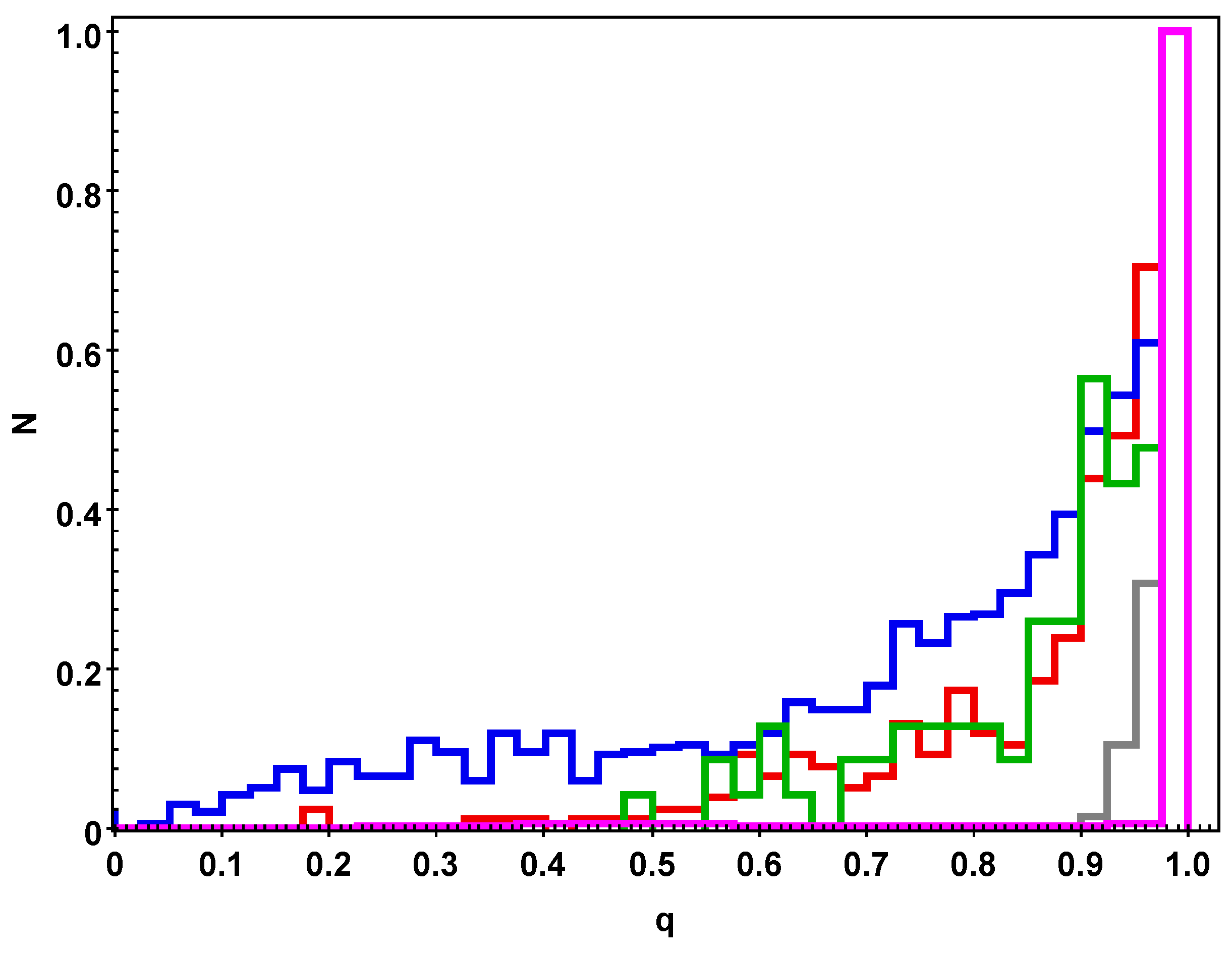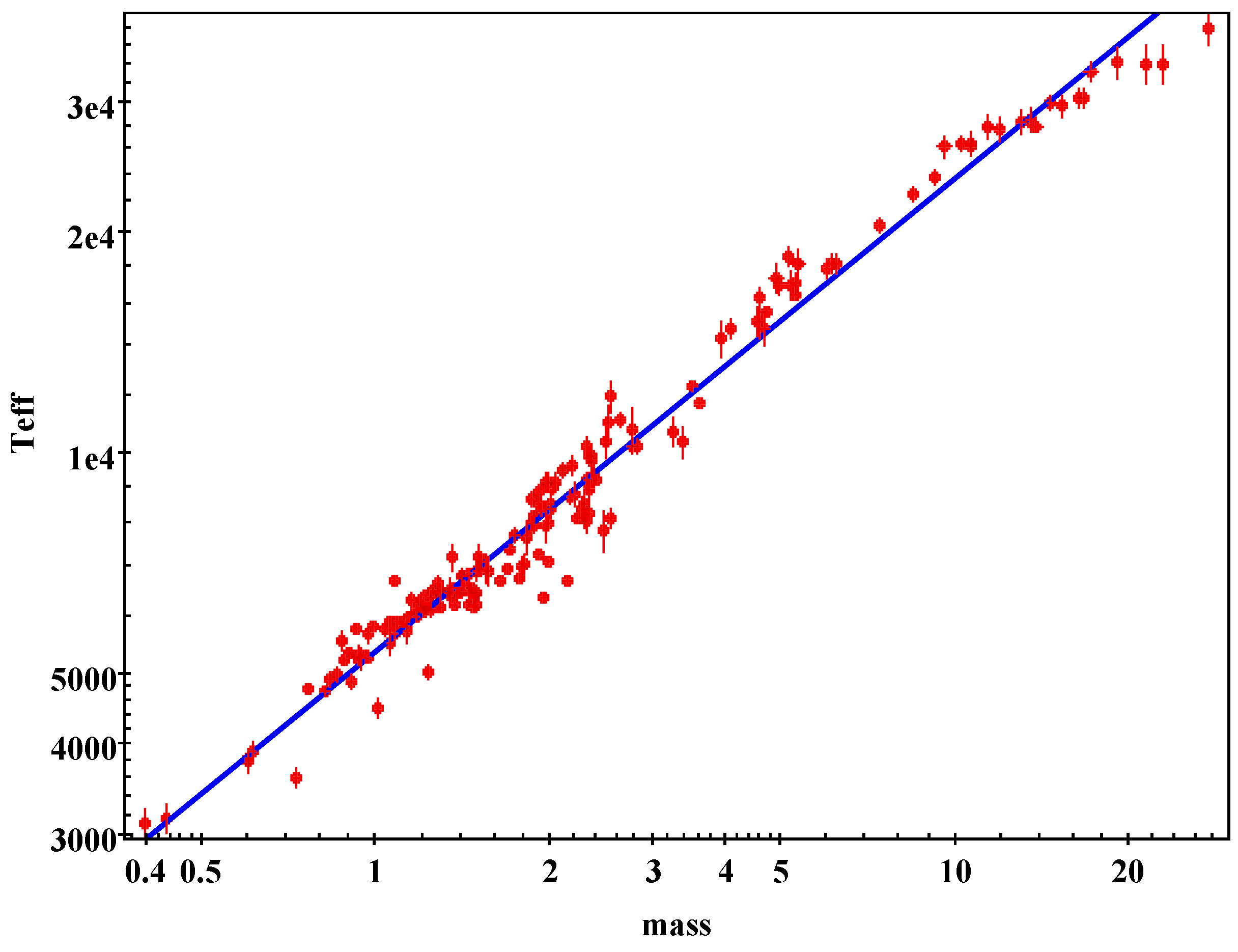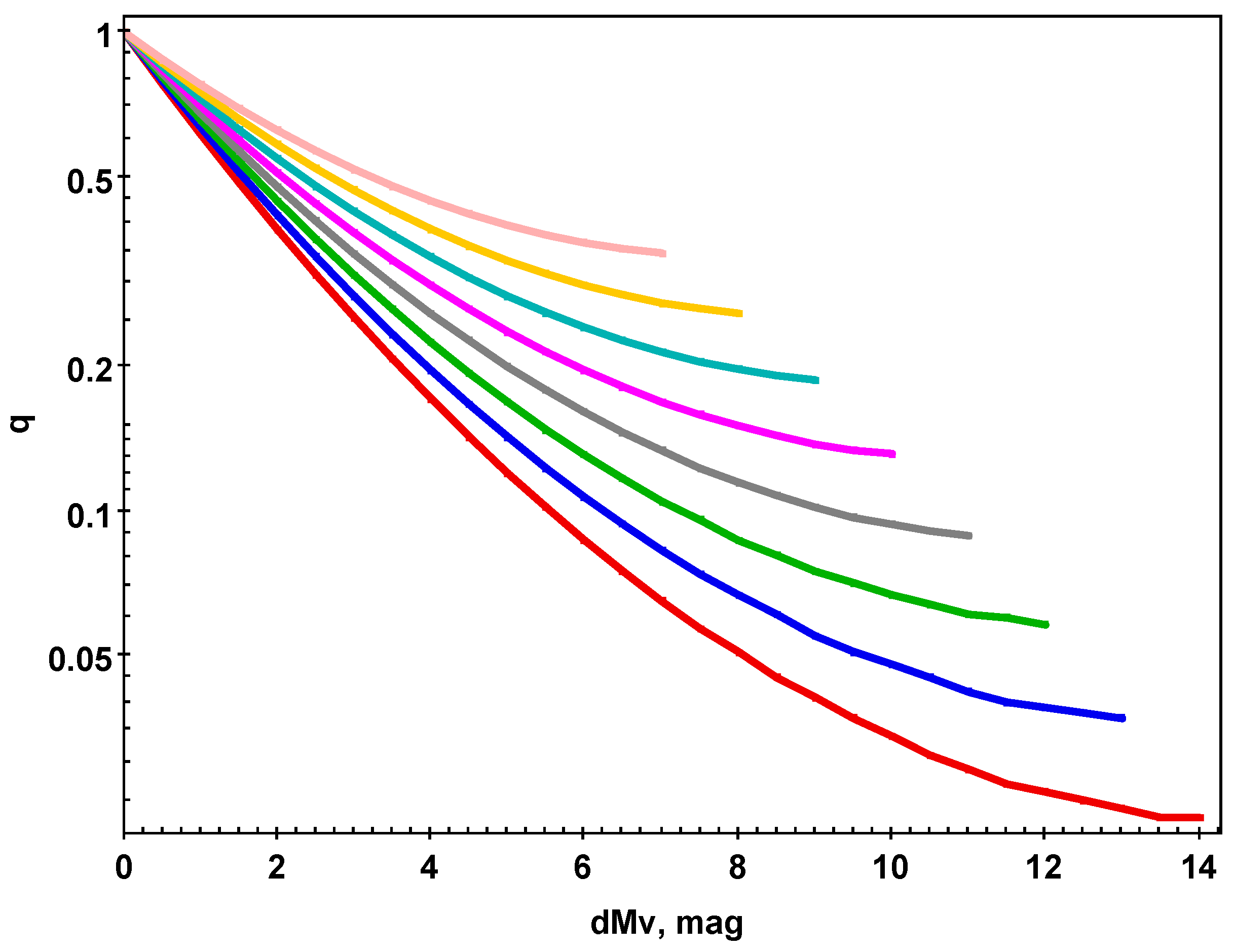Submitted:
07 August 2023
Posted:
08 August 2023
You are already at the latest version
Abstract
Keywords:
1. Introduction
2. Mass ratio distribution of binaries
2.1. Spectroscopic binaries
2.2. Orbital binaries
2.3. Double lined eclipsing binaries
2.4. Detached main-sequence eclipsing binaries
2.5. Gaia DR3 non single stars
2.6. Interferometric binaries

3. Gaia BH1 – a rare low-q binary
Funding
Data Availability Statement
Acknowledgments
Conflicts of Interest
Abbreviations
| SB9 | 9th Catalogue of Spectroscopic Binary Orbits |
| ORB6 | Sixth Catalog of Orbits of Visual Binary Stars |
| DLEB | Double lined eclipsing binaries |
| CEV | Catalogue of eclipsing variables |
| DM | Detached main-sequence |
| NSS | Non single star |
| INT4 | Fourth Catalog of Interferometric Measurements of Binary Stars |
| CHARM2 | An updated Catalog of High Angular Resolution Measurements |
| MLR | Mass-luminosity relation |
| IMF | Initial mass function |
References
- El-Badry, K.; Rix, H.W.; Quataert, E.; Howard, A.W.; Isaacson, H.; Fuller, J.; Hawkins, K.; Breivik, K.; Wong, K.W.K.; Rodriguez, A.C.; Conroy, C.; Shahaf, S.; Mazeh, T.; Arenou, F.; Burdge, K.B.; Bashi, D.; Faigler, S.; Weisz, D.R.; Seeburger, R.; Almada Monter, S.; Wojno, J. A Sun-like star orbiting a black hole. Monthly Notices Royal Astron. Soc. 2023, arXiv:astro-ph.SR/2209.06833518, 1057–1085. [Google Scholar] [CrossRef]
- Pombo, A.M.; Saltas, I.D. A Sun-like star orbiting a boson star. arXiv e-prints 2023, arXiv:2304.09140. [Google Scholar] [CrossRef]
- Pourbaix, D.; Tokovinin, A.A.; Batten, A.H.; Fekel, F.C.; Hartkopf, W.I.; Levato, H.; Morrell, N.I.; Torres, G.; Udry, S. SB<SUP>9</SUP>: The ninth catalogue of spectroscopic binary orbits. Astron. and Astrophys. 2004, 424424, 727–732. [Google Scholar] [CrossRef]
- Chulkov, D.; Malkov, O. Visual binary stars with known orbits in Gaia EDR3. Monthly Notices Royal Astron. Soc. 2022, arXiv:astro-ph.SR/2206.00604517, 2925–2941. [Google Scholar] [CrossRef]
- Hartkopf, W.I.; Mason, B.D.; Worley, C.E. The 2001 US Naval Observatory Double Star CD-ROM. II. The Fifth Catalog of Orbits of Visual Binary Stars. Astron. J. 2001, 122, 3472–3479. [Google Scholar] [CrossRef]
- Torres, G.; Andersen, J.; Giménez, A. Accurate masses and radii of normal stars: modern results and applications. Astron. and Astrophys. 2010, arXiv:astro-ph.SR/0908.262418, 67–126. [Google Scholar] [CrossRef]
- Brancewicz, H.K.; Dworak, T.Z. A catalogue of parameters for eclipsing binaries. Acta Astronomica 1980, 30, 501–524. [Google Scholar]
- Malkov, O.Y. Mass-luminosity relation of intermediate-mass stars. Monthly Notices Royal Astron. Soc. 2007, 382, 1073–1086. [Google Scholar] [CrossRef]
- Avvakumova, E.A.; Malkov, O.Y.; Kniazev, A.Y. Eclipsing variables: Catalogue and classification. Astronomische Nachrichten 2013, 334, 860. [Google Scholar] [CrossRef]
- Avvakumova, E.A.; Malkov, O.Y. Assessment of evolutionary status of eclipsing binaries using light-curve parameters and spectral classification. Monthly Notices Royal Astron. Soc. 2014, arXiv:astro-ph.SR/1408.0870444, 1982–1992. [Google Scholar] [CrossRef]
- Gaia Collaboration; Vallenari, A.; Brown, A.G.A.; Prusti, T.; de Bruijne, J.H.J.; Arenou, F.; Babusiaux, C.; Biermann, M.; Creevey, O.L.; Ducourant, C.; Evans, D.W.; Eyer, L.; Guerra, R.; Hutton, A.; Jordi, C.; Klioner, S.A.; Lammers, U.L.; Lindegren, L.; Luri, X.; Mignard, F.; Panem, C.; Pourbaix, D.; Randich, S.; Sartoretti, P.; Soubiran, C.; Tanga, P.; Walton, N.A.; Bailer-Jones, C.A.L.; Bastian, U.; Drimmel, R.; Jansen, F.; Katz, D.; Lattanzi, M.G.; van Leeuwen, F.; Bakker, J.; Cacciari, C.; Castañeda, J.; De Angeli, F.; Fabricius, C.; Fouesneau, M.; Frémat, Y.; Galluccio, L.; Guerrier, A.; Heiter, U.; Masana, E.; Messineo, R.; Mowlavi, N.; Nicolas, C.; Nienartowicz, K.; Pailler, F.; Panuzzo, P.; Riclet, F.; Roux, W.; Seabroke, G.M.; Sordoørcit, R.; Thévenin, F.; Gracia-Abril, G.; Portell, J.; Teyssier, D.; Altmann, M.; Andrae, R.; Audard, M.; Bellas-Velidis, I.; Benson, K.; Berthier, J.; Blomme, R.; Burgess, P.W.; Busonero, D.; Busso, G.; Cánovas, H.; Carry, B.; Cellino, A.; Cheek, N.; Clementini, G.; Damerdji, Y.; Davidson, M.; de Teodoro, P.; Nuñez Campos, M.; Delchambre, L.; Dell’Oro, A.; Esquej, P.; Fernández-Hernández, J.; Fraile, E.; Garabato, D.; García-Lario, P.; Gosset, E.; Haigron, R.; Halbwachs, J.L.; Hambly, N.C.; Harrison, D.L.; Hernández, J.; Hestroffer, D.; Hodgkin, S.T.; Holl, B.; Janßen, K.; Jevardat de Fombelle, G.; Jordan, S.; Krone-Martins, A.; Lanzafame, A.C.; Löffler, W.; Marchal, O.; Marrese, P.M.; Moitinho, A.; Muinonen, K.; Osborne, P.; Pancino, E.; Pauwels, T.; Recio-Blanco, A.; Reylé, C.; Riello, M.; Rimoldini, L.; Roegiers, T.; Rybizki, J.; Sarro, L.M.; Siopis, C.; Smith, M.; Sozzetti, A.; Utrilla, E.; van Leeuwen, M.; Abbas, U.; Ábrahám, P.; Abreu Aramburu, A.; Aerts, C.; Aguado, J.J.; Ajaj, M.; Aldea-Montero, F.; Altavilla, G.; Álvarez, M.A.; Alves, J.; Anders, F.; Anderson, R.I.; Anglada Varela, E.; Antoja, T.; Baines, D.; Baker, S.G.; Balaguer-Núñez, L.; Balbinot, E.; Balog, Z.; Barache, C.; Barbato, D.; Barros, M.; Barstow, M.A.; Bartolomé, S.; Bassilana, J.L.; Bauchet, N.; Becciani, U.; Bellazzini, M.; Berihuete, A.; Bernet, M.; Bertone, S.; Bianchi, L.; Binnenfeld, A.; Blanco-Cuaresma, S.; Blazere, A.; Boch, T.; Bombrun, A.; Bossini, D.; Bouquillon, S.; Bragaglia, A.; Bramante, L.; Breedt, E.; Bressan, A.; Brouillet, N.; Brugaletta, E.; Bucciarelli, B.; Burlacu, A.; Butkevich, A.G.; Buzzi, R.; Caffau, E.; Cancelliere, R.; Cantat-Gaudin, T.; Carballo, R.; Carlucci, T.; Carnerero, M.I.; Carrasco, J.M.; Casamiquela, L.; Castellani, M.; Castro-Ginard, A.; Chaoul, L.; Charlot, P.; Chemin, L.; Chiaramida, V.; Chiavassa, A.; Chornay, N.; Comoretto, G.; Contursi, G.; Cooper, W.J.; Cornez, T.; Cowell, S.; Crifo, F.; Cropper, M.; Crosta, M.; Crowley, C.; Dafonte, C.; Dapergolas, A.; David, M.; David, P.; de Laverny, P.; De Luise, F.; De March, R.; De Ridder, J.; de Souza, R.; de Torres, A.; del Peloso, E.F.; del Pozo, E.; Delbo, M.; Delgado, A.; Delisle, J.B.; Demouchy, C.; Dharmawardena, T.E.; Di Matteo, P.; Diakite, S.; Diener, C.; Distefano, E.; Dolding, C.; Edvardsson, B.; Enke, H.; Fabre, C.; Fabrizio, M.; Faigler, S.; Fedorets, G.; Fernique, P.; Fienga, A.; Figueras, F.; Fournier, Y.; Fouron, C.; Fragkoudi, F.; Gai, M.; Garcia-Gutierrez, A.; Garcia-Reinaldos, M.; García-Torres, M.; Garofalo, A.; Gavel, A.; Gavras, P.; Gerlach, E.; Geyer, R.; Giacobbe, P.; Gilmore, G.; Girona, S.; Giuffrida, G.; Gomel, R.; Gomez, A.; González-Núñez, J.; González-Santamaría, I.; González-Vidal, J.J.; Granvik, M.; Guillout, P.; Guiraud, J.; Gutiérrez-Sánchez, R.; Guy, L.P.; Hatzidimitriou, D.; Hauser, M.; Haywood, M.; Helmer, A.; Helmi, A.; Sarmiento, M.H.; Hidalgo, S.L.; Hilger, T.; Hładczuk, N.; Hobbs, D.; Holland, G.; Huckle, H.E.; Jardine, K.; Jasniewicz, G.; Jean-Antoine Piccolo, A.; Jiménez-Arranz, Ó.; Jorissen, A.; Juaristi Campillo, J.; Julbe, F.; Karbevska, L.; Kervella, P.; Khanna, S.; Kontizas, M.; Kordopatis, G.; Korn, A.J.; Kóspál, Á.; Kostrzewa-Rutkowska, Z.; Kruszyńska, K.; Kun, M.; Laizeau, P.; Lambert, S.; Lanza, A.F.; Lasne, Y.; Le Campion, J.F.; Lebreton, Y.; Lebzelter, T.; Leccia, S.; Leclerc, N.; Lecoeur-Taibi, I.; Liao, S.; Licata, E.L.; Lindstrøm, H.E.P.; Lister, T.A.; Livanou, E.; Lobel, A.; Lorca, A.; Loup, C.; Madrero Pardo, P.; Magdaleno Romeo, A.; Managau, S.; Mann, R.G.; Manteiga, M.; Marchant, J.M.; Marconi, M.; Marcos, J.; Marcos Santos, M.M.S.; Marín Pina, D.; Marinoni, S.; Marocco, F.; Marshall, D.J.; Polo, L.M.; Martín-Fleitas, J.M.; Marton, G.; Mary, N.; Masip, A.; Massari, D.; Mastrobuono-Battisti, A.; Mazeh, T.; McMillan, P.J.; Messina, S.; Michalik, D.; Millar, N.R.; Mints, A.; Molina, D.; Molinaro, R.; Molnár, L.; Monari, G.; Monguió, M.; Montegriffo, P.; Montero, A.; Mor, R.; Mora, A.; Morbidelli, R.; Morel, T.; Morris, D.; Muraveva, T.; Murphy, C.P.; Musella, I.; Nagy, Z.; Noval, L.; Ocaña, F.; Ogden, A.; Ordenovic, C.; Osinde, J.O.; Pagani, C.; Pagano, I.; Palaversa, L.; Palicio, P.A.; Pallas-Quintela, L.; Panahi, A.; Payne-Wardenaar, S.; Peñalosa Esteller, X.; Penttilä, A.; Pichon, B.; Piersimoni, A.M.; Pineau, F.X.; Plachy, E.; Plum, G.; Poggio, E.; Prša, A.; Pulone, L.; Racero, E.; Ragaini, S.; Rainer, M.; Raiteri, C.M.; Rambaux, N.; Ramos, P.; Ramos-Lerate, M.; Re Fiorentin, P.; Regibo, S.; Richards, P.J.; Rios Diaz, C.; Ripepi, V.; Riva, A.; Rix, H.W.; Rixon, G.; Robichon, N.; Robin, A.C.; Robin, C.; Roelens, M.; Rogues, H.R.O.; Rohrbasser, L.; Romero-Gómez, M.; Rowell, N.; Royer, F.; Ruz Mieres, D.; Rybicki, K.A.; Sadowski, G.; Sáez Núñez, A.; Sagristà Sellés, A.; Sahlmann, J.; Salguero, E.; Samaras, N.; Sanchez Gimenez, V.; Sanna, N.; Santoveña, R.; Sarasso, M.; Schultheis, M.; Sciacca, E.; Segol, M.; Segovia, J.C.; Ségransan, D.; Semeux, D.; Shahaf, S.; Siddiqui, H.I.; Siebert, A.; Siltala, L.; Silvelo, A.; Slezak, E.; Slezak, I.; Smart, R.L.; Snaith, O.N.; Solano, E.; Solitro, F.; Souami, D.; Souchay, J.; Spagna, A.; Spina, L.; Spoto, F.; Steele, I.A.; Steidelmüller, H.; Stephenson, C.A.; Süveges, M.; Surdej, J.; Szabados, L.; Szegedi-Elek, E.; Taris, F.; Taylo, M.B.; Teixeira, R.; Tolomei, L.; Tonello, N.; Torra, F.; Torra, J.; Torralba Elipe, G.; Trabucchi, M.; Tsounis, A.T.; Turon, C.; Ulla, A.; Unger, N.; Vaillant, M.V.; van Dillen, E.; van Reeven, W.; Vanel, O.; Vecchiato, A.; Viala, Y.; Vicente, D.; Voutsinas, S.; Weiler, M.; Wevers, T.; Wyrzykowski, L.; Yoldas, A.; Yvard, P.; Zhao, H.; Zorec, J.; Zucker, S.; Zwitter, T. Gaia Data Release 3: Summary of the content and survey properties. arXiv e-prints 2022, arXiv:2208.00211. [Google Scholar]
- Gaia Collaboration; Arenou, F.; Babusiaux, C.; Barstow, M.A.; Faigler, S.; Jorissen, A.; Kervella, P.; Mazeh, T.; Mowlavi, N.; Panuzzo, P.; Sahlmann, J.; Shahaf, S.; Sozzetti, A.; Bauchet, N.; Damerdji, Y.; Gavras, P.; Giacobbe, P.; Gosset, E.; Halbwachs, J.L.; Holl, B.; Lattanzi, M.G.; Leclerc, N.; Morel, T.; Pourbaix, D.; Re Fiorentin, P.; Sadowski, G.; Ségransan, D.; Siopis, C.; Teyssier, D.; Zwitter, T.; Planquart, L.; Brown, A.G.A.; Vallenari, A.; Prusti, T.; de Bruijne, J.H.J.; Biermann, M.; Creevey, O.L.; Ducourant, C.; Evans, D.W.; Eyer, L.; Guerra, R.; Hutton, A.; Jordi, C.; Klioner, S.A.; Lammers, U.L.; Lindegren, L.; Luri, X.; Mignard, F.; Panem, C.; Randich, S.; Sartoretti, P.; Soubiran, C.; Tanga, P.; Walton, N.A.; Bailer-Jones, C.A.L.; Bastian, U.; Drimmel, R.; Jansen, F.; Katz, D.; van Leeuwen, F.; Bakker, J.; Cacciari, C.; Castañeda, J.; De Angeli, F.; Fabricius, C.; Fouesneau, M.; Frémat, Y.; Galluccio, L.; Guerrier, A.; Heiter, U.; Masana, E.; Messineo, R.; Nicolas, C.; Nienartowicz, K.; Pailler, F.; Riclet, F.; Roux, W.; Seabroke, G.M.; Sordo, R.; Thévenin, F.; Gracia-Abril, G.; Portell, J.; Altmann, M.; Andrae, R.; Audard, M.; Bellas-Velidis, I.; Benson, K.; Berthier, J.; Blomme, R.; Burgess, P.W.; Busonero, D.; Busso, G.; Cánovas, H.; Carry, B.; Cellino, A.; Cheek, N.; Clementini, G.; Davidson, M.; de Teodoro, P.; Nuñez Campos, M.; Delchambre, L.; Dell’Oro, A.; Esquej, P.; Fernández-Hernández, J.; Fraile, E.; Garabato, D.; García-Lario, P.; Haigron, R.; Hambly, N.C.; Harrison, D.L.; Hernández, J.; Hestroffer, D.; Hodgkin, S.T.; Janßen, K.; Jevardat de Fombelle, G.; Jordan, S.; Krone-Martins, A.; Lanzafame, A.C.; Löffler, W.; Marchal, O.; Marrese, P.M.; Moitinho, A.; Muinonen, K.; Osborne, P.; Pancino, E.; Pauwels, T.; Recio-Blanco, A.; Reylé, C.; Riello, M.; Rimoldini, L.; Roegiers, T.; Rybizki, J.; Sarro, L.M.; Smith, M.; Utrilla, E.; van Leeuwen, M.; Abbas, U.; Ábrahám, P.; Abreu Aramburu, A.; Aerts, C.; Aguado, J.J.; Ajaj, M.; Aldea-Montero, F.; Altavilla, G.; Álvarez, M.A.; Alves, J.; Anders, F.; Anderson, R.I.; Anglada Varela, E.; Antoja, T.; Baines, D.; Baker, S.G.; Balaguer-Núñez, L.; Balbinot, E.; Balog, Z.; Barache, C.; Barbato, D.; Barros, M.; Bartolomé, S.; Bassilana, J.L.; Becciani, U.; Bellazzini, M.; Berihuete, A.; Bernet, M.; Bertone, S.; Bianchi, L.; Binnenfeld, A.; Blanco-Cuaresma, S.; Blazere, A.; Boch, T.; Bombrun, A.; Bossini, D.; Bouquillon, S.; Bragaglia, A.; Bramante, L.; Breedt, E.; Bressan, A.; Brouillet, N.; Brugaletta, E.; Bucciarelli, B.; Burlacu, A.; Butkevich, A.G.; Buzzi, R.; Caffau, E.; Cancelliere, R.; Cantat-Gaudin, T.; Carballo, R.; Carlucci, T.; Carnerero, M.I.; Carrasco, J.M.; Casamiquela, L.; Castellani, M.; Castro-Ginard, A.; Chaoul, L.; Charlot, P.; Chemin, L.; Chiaramida, V.; Chiavassa, A.; Chornay, N.; Comoretto, G.; Contursi, G.; Cooper, W.J.; Cornez, T.; Cowell, S.; Crifo, F.; Cropper, M.; Crosta, M.; Crowley, C.; Dafonte, C.; Dapergolas, A.; David, P.; de Laverny, P.; De Luise, F.; De March, R.; De Ridder, J.; de Souza, R.; de Torres, A.; del Peloso, E.F.; del Pozo, E.; Delbo, M.; Delgado, A.; Delisle, J.B.; Demouchy, C.; Dharmawardena, T.E.; Diakite, S.; Diener, C.; Distefano, E.; Dolding, C.; Enke, H.; Fabre, C.; Fabrizio, M.; Fedorets, G.; Fernique, P.; Figueras, F.; Fournier, Y.; Fouron, C.; Fragkoudi, F.; Gai, M.; Garcia-Gutierrez, A.; Garcia-Reinaldos, M.; García-Torres, M.; Garofalo, A.; Gavel, A.; Gerlach, E.; Geyer, R.; Gilmore, G.; Girona, S.; Giuffrida, G.; Gomel, R.; Gomez, A.; González-Núñez, J.; González-Santamaría, I.; González-Vidal, J.J.; Granvik, M.; Guillout, P.; Guiraud, J.; Gutiérrez-Sánchez, R.; Guy, L.P.; Hatzidimitriou, D.; Hauser, M.; Haywood, M.; Helmer, A.; Helmi, A.; Sarmiento, M.H.; Hidalgo, S.L.; Hilger, T.; Hładczuk, N.; Hobbs, D.; Holland, G.; Huckle, H.E.; Jardine, K.; Jasniewicz, G.; Jean-Antoine Piccolo, A.; Jiménez-Arranz, Ó.; Juaristi Campillo, J.; Julbe, F.; Karbevska, L.; Khanna, S.; Kordopatis, G.; Korn, A.J.; Kóspál, Á.; Kostrzewa-Rutkowska, Z.; Kruszyńska, K.; Kun, M.; Laizeau, P.; Lambert, S.; Lanza, A.F.; Lasne, Y.; Le Campion, J.F.; Lebreton, Y.; Lebzelter, T.; Leccia, S.; Lecoeur-Taibi, I.; Liao, S.; Licata, E.L.; Lindstrøm, H.E.P.; Lister, T.A.; Livanou, E.; Lobel, A.; Lorca, A.; Loup, C.; Madrero Pardo, P.; Magdaleno Romeo, A.; Managau, S.; Mann, R.G.; Manteiga, M.; Marchant, J.M.; Marconi, M.; Marcos, J.; Marcos Santos, M.M.S.; Marín Pina, D.; Marinoni, S.; Marocco, F.; Marshall, D.J.; Martin Polo, L.; Martín-Fleitas, J.M.; Marton, G.; Mary, N.; Masip, A.; Massari, D.; Mastrobuono-Battisti, A.; McMillan, P.J.; Messina, S.; Michalik, D.; Millar, N.R.; Mints, A.; Molina, D.; Molinaro, R.; Molnár, L.; Monari, G.; Monguió, M.; Montegriffo, P.; Montero, A.; Mor, R.; Mora, A.; Morbidelli, R.; Morris, D.; Muraveva, T.; Murphy, C.P.; Musella, I.; Nagy, Z.; Noval, L.; Ocaña, F.; Ogden, A.; Ordenovic, C.; Osinde, J.O.; Pagani, C.; Pagano, I.; Palaversa, L.; Palicio, P.A.; Pallas-Quintela, L.; Panahi, A.; Payne-Wardenaar, S.; Peñalosa Esteller, X.; Penttilä, A.; Pichon, B.; Piersimoni, A.M.; Pineau, F.X.; Plachy, E.; Plum, G.; Poggio, E.; Prša, A.; Pulone, L.; Racero, E.; Ragaini, S.; Rainer, M.; Raiteri, C.M.; Ramos, P.; Ramos-Lerate, M.; Regibo, S.; Richards, P.J.; Rios Diaz, C.; Ripepi, V.; Riva, A.; Rix, H.W.; Rixon, G.; Robichon, N.; Robin, A.C.; Robin, C.; Roelens, M.; Rogues, H.R.O.; Rohrbasser, L.; Romero-Gómez, M.; Rowell, N.; Royer, F.; Ruz Mieres, D.; Rybicki, K.A.; Sáez Núñez, A.; Sagristà Sellés, A.; Salguero, E.; Samaras, N.; Sanchez Gimenez, V.; Sanna, N.; Santoveña, R.; Sarasso, M.; Schultheis, M.; Sciacca, E.; Segol, M.; Segovia, J.C.; Semeux, D.; Siddiqui, H.I.; Siebert, A.; Siltala, L.; Silvelo, A.; Slezak, E.; Slezak, I.; Smart, R.L.; Snaith, O.N.; Solano, E.; Solitro, F.; Souami, D.; Souchay, J.; Spagna, A.; Spina, L.; Spoto, F.; Steele, I.A.; Steidelmüller, H.; Stephenson, C.A.; Süveges, M.; Surdej, J.; Szabados, L.; Szegedi-Elek, E.; Taris, F.; Taylor, M.B.; Teixeira, R.; Tolomei, L.; Tonello, N.; Torra, F.; Torra, J.; Torralba Elipe, G.; Trabucchi, M.; Tsounis, A.T.; Turon, C.; Ulla, A.; Unger, N.; Vaillant, M.V.; van Dillen, E.; van Reeven, W.; Vanel, O.; Vecchiato, A.; Viala, Y.; Vicente, D.; Voutsinas, S.; Weiler, M.; Wevers, T.; Wyrzykowski, L.; Yoldas, A.; Yvard, P.; Zhao, H.; Zorec, J.; Zucker, S. Gaia Data Release 3. Stellar multiplicity, a teaser for the hidden treasure. Astron. and Astrophys. 2023, arXiv:astro-ph.SR/2206.05595674, A34. [Google Scholar] [CrossRef]
- Straižys, V. Multicolor stellar photometry; 1992.
- Balega, I.; Balega, Y.Y.; Maksimov, A.F.; Pluzhnik, E.A.; Schertl, D.; Shkhagosheva, Z.U.; Weigelt, G. Speckle interferometry of nearby multiple stars. II. Astron. and Astrophys. 2004, 422, 627–629. [Google Scholar] [CrossRef]
- Richichi, A.; Percheron, I.; Khristoforova, M. CHARM2: An updated Catalog of High Angular Resolution Measurements. Astron. and Astrophys. 2005, 431, 773–777. [Google Scholar] [CrossRef]
- Strakhov, I.A.; Safonov, B.S.; Cheryasov, D.V. Speckle Interferometry with CMOS Detector. Astrophysical Bulletin 2023, arXiv:astro-ph.IM/2305.00451]78, 234–258. [Google Scholar] [CrossRef]
- Chevalier, S.; Babusiaux, C.; Merle, T.; Arenou, F. Binaries masses and luminosities with Gaia DR3. arXiv e-prints 2023, arXiv:2307.16719. [Google Scholar] [CrossRef]
- Piskunov, A.E.; Mal’Kov, O.I. Unresolved binaries and the stellar luminosity function. Astron. and Astrophys. 1991, 247, 87–90. [Google Scholar]
- Malkov, O.; Piskunov, A.; Zinnecker, H. On the luminosity ratio of pre-main sequence binaries. Astron. and Astrophys. 1998, 338, 452–454. [Google Scholar]
- Kroupa, P.; Weidner, C.; Pflamm-Altenburg, J.; Thies, I.; Dabringhausen, J.; Marks, M.; Maschberger, T. The Stellar and Sub-Stellar Initial Mass Function of Simple and Composite Populations. In Planets, Stars and Stellar Systems. Volume 5: Galactic Structure and Stellar Populations; Oswalt, T.D., Gilmore, G., Eds.; 2013; Vol. 5, p. 115. [Google Scholar] [CrossRef]
- Chulkov, D. Pairing function of visual binary stars. Monthly Notices Royal Astron. Soc. 2021, arXiv:astro-ph.SR/2011.07426501, 769–783. [Google Scholar] [CrossRef]
- Fryer, C.L.; Belczynski, K.; Wiktorowicz, G.; Dominik, M.; Kalogera, V.; Holz, D.E. Compact Remnant Mass Function: Dependence on the Explosion Mechanism and Metallicity. Astrophys. J. 2012, arXiv:astro-ph.SR/1110.1726749, 91. [Google Scholar] [CrossRef]
- Malkov, O.Y. On the mass distribution of stellar-mass black holes. Baltic Astronomy 2014, 23, 267–271. [Google Scholar] [CrossRef]


| Catalogue | Star | SpT | q | ||||
|---|---|---|---|---|---|---|---|
| Balega+ | 111 | 0 | Ori A | 3.23 | B0V | 0.45 | |
| CHARM2 | 313 | 0 | Ari | 23.8 | 3.44 | A3V | 0.23 |
| Strakhov+ | 372 | 1 | HD 340178 | 315.5 | 6.25 | A3 | 0.09 |
| Source ID | NSS solution type | ||
|---|---|---|---|
| 4373465352415301632 (BH1) | Orbital | 0.95 | 12.81 |
| 1864406790238257536 | AstroSpectroSB1 | 2.40 | 20.08 |
| 3640889032890567040 | Orbital | 1.01 | 123.47 |
| 6281177228434199296 | Orbital | 0.95 | 11.91 |
Disclaimer/Publisher’s Note: The statements, opinions and data contained in all publications are solely those of the individual author(s) and contributor(s) and not of MDPI and/or the editor(s). MDPI and/or the editor(s) disclaim responsibility for any injury to people or property resulting from any ideas, methods, instructions or products referred to in the content. |
© 2020 by the author. Licensee MDPI, Basel, Switzerland. This article is an open access article distributed under the terms and conditions of the Creative Commons Attribution (CC BY) license (https://creativecommons.org/licenses/by/4.0/).





